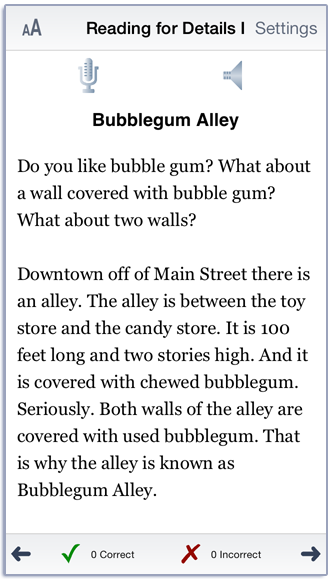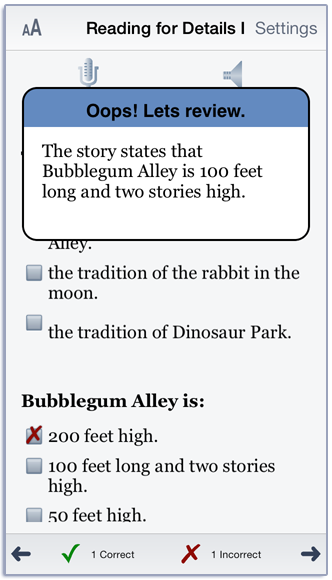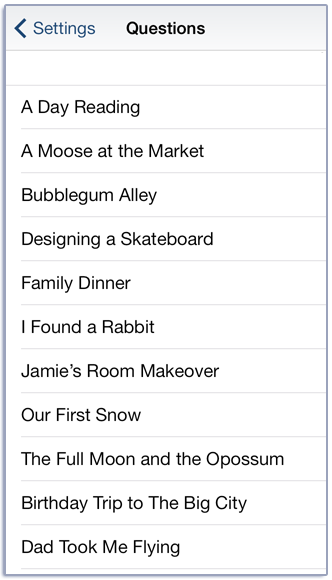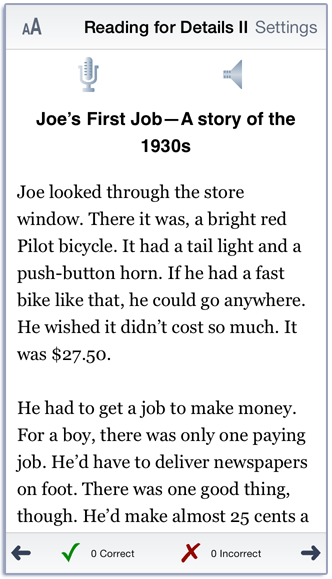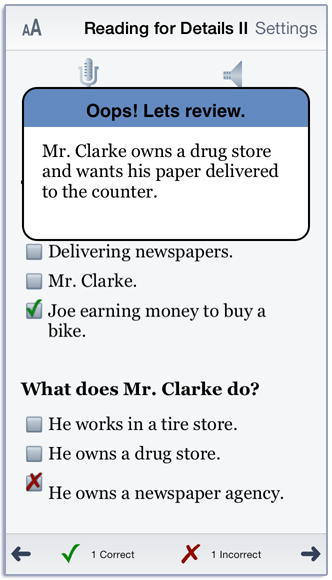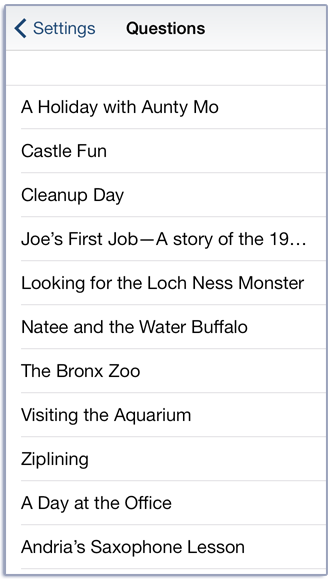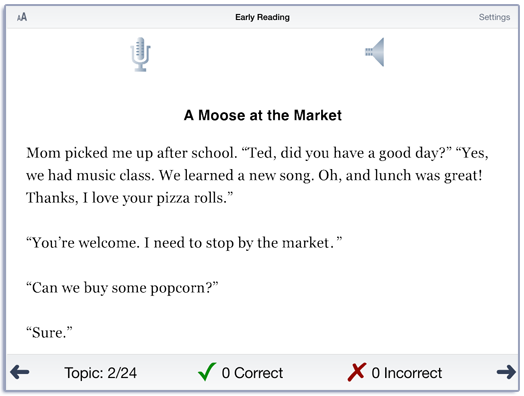
These apps have stories about adventures, activities, nature, and human interests. All require careful reading to comprehend and recall details in order to answer the comprehension questions that follow. The student is asked to determine the main idea of the story, answer some questions that rely on details in the story, and make an inference that is supported by the details. At the end of each story, there is an open-ended question for discussion. The questions have a written explanation as to why the correct answer is correct and the other answers are incorrect. The metacognitive skills acquired through this app will help the student learn from their mistakes, learn to read for details, and learn how to develop higher order thinking skills (HOTS).
You can read the stories in any order, however we have provided a default order based on complexity, vocabulary, and number of details.
Tap the Play button (or the big button in the middle of the screen) to read the first story. Pay close attention to details in the story. When you have finished reading, determine the overall theme. Then swipe to the next page and demonstrate comprehension by answering four multiple choice questions. Swipe again to discuss an open-ended question. Sometimes the device interprets a swipe as a scroll. If you are having trouble swiping, use the arrow keys at the bottom of the screen to move around.
The app scores correct and incorrect answers and keeps track of the questions that were answered incorrectly. When a question is answered incorrectly a popup appears with a discussion of the answers. The popup explains why some of the incorrect answers are wrong and the correct answer is right.
You can make the text larger or smaller by tapping the resize button  at the top left of the screen.
at the top left of the screen.
This app was designed for individuals who need extra practice with reading comprehension and learning how to recall specific details of stories. It is also appropriate for children and adults with traumatic brain injuries or stroke. Ideally, the student will work with a parent, teacher, or therapist while using the app. The mentor can guide the student’s reading strategies while using the app as a source of stories and questions.
Reading for Details I has short sentences with a vocabulary that is appropriate for third-grade readers. Sentence structure is simple and information is directly stated. Paragraphs are usually short.
Reading for Details II has stories written by authors from around the world and a vocabulary that should be familiar to fourth through sixth-grade students. Many of the stories are set in countries outside the US. Words and phrases from other cultures are often used in these stories. Mentors are encouraged to use the cultural diversity and differing perspectives in the stories to assist the reader with seeing events from another’s perspective.
As the students read the stories, they should focus on the details of the story. At the end of the story, they should pause and decide what the story was mostly about. The first question asks them to identify the main idea of the story. Then there are two questions about details in the story. These are often of the form, How Many, Who, Which, or Where. There are no trick questions in the app. However, there are choices that contain details from the story that are not the answer to the question. These foils are intentionally placed to make sure the reader is reading for information and not just using recognition memory to answer the question.
Often the student gets a question wrong because they focus on a detail of the story. Sometimes they recognize words or numbers in the answers and choose an answer because the words are familiar. The popup explains why incorrect answers may appear to be correct. It also explains why the correct answer is, in fact, the right choice. After the student studies the explanation, they should read the question again and answer it using the knowledge gained from the explanation. If they want, the student can swipe back to the story, reread the story, and look for the answer in the story. An option lets the student choose to see the explanations after each answer is selected, rather than just after incorrect answers.
The last question requires that the student make inferences about the characters in the story. Based on the details and overall theme of the story, the student is asked to guess which of four statements is likely to be true. After the student answers, a popup explains why one answer is probably correct and the others are not as likely to be correct. Like the other questions, one answer is usually obviously incorrect. Two answers usually have have details from the story but are less likely to be true.
The app scores correct and incorrect answers and keeps track of the questions that were answered incorrectly. Results can be emailed or downloaded from iTunes.
The process for reading comprehension work is the same as for auditory comprehension, except you will ask your students to read the sentences, either aloud or to themselves, before creating the visual images to match. Proceed slowly through the process of imaging each sentence. Taking time to understand each new word or concept is important. It is possible to spend fifteen minutes or more on a story. This is not inefficient. You are teaching a process that will become faster and more reliable. Speed is not the primary objective when first learning to have efficient comprehension. The sequence should be: understand individual words; understand the sentence; understand how the sentence relates to the one before it; understand how the sentence relates to something you already know; understand how the sentence relates to yourself or the world; make a judgment on the new information.
View the settings by tapping the Settings button at the top of the main game-play screen or at the bottom of the intro screen.
Pick a story from the Stories option. If you don’t pick a story then the app will start at the first story and continue sequentially.
You can download the stories and questions from our website.
The Options tab lets you sign in and the app will remember the name until you change it. If you enter a name, the results files will be stored with the name appended. e.g. Comprehension Results Child One 2015-02-27.html
You may show the explanation after every question is answered by tapping on the Always Show Explanation button.
When you change the name, a new file of results will be created. If you want to clear out the current results file, but not change the name, you can touch the Reset Scoring button.
The Results tab shows the results for the day. The app collects data on the total Correct and Incorrect answers. A new results file is created when you change the sign in name or when the day changes.
You can print the results or use iTunes to copy the day’s results file to your computer for printing or archiving. The printed results include percentages as well as raw numbers for the responses. To view the results pages in iTunes, plug your iPad or iPod into your computer. Open iTunes. Under Devices you’ll see your device. Click on the device and look at the top of the screen. You will see a tab labeled Apps. Under that tab, there is a section for File Sharing. The name and icon for this app will be displayed. In the documents list next to it you will find all of the results pages that are stored on the device. Drag them to your desktop. They will open in your web browser where you can print them.
The student will attend and utilize auditory and/or visual memory to process, remember, and use information presented at the single word, phrase, sentence, and paragraph levels.
The stories require multiple processing skills in attention, memory, and comprehension. Some individuals may need to address comprehension at the word or sentence level, but the eventual goal is comprehension at the paragraph level. It requires visual discrimination, and reading comprehension. The developed higher level comprehension skills such as getting the main idea, inferring, predicting outcome, concluding consequences and evaluating the relevance of the material allow practice opportunities for improving reading comprehension and oral or written expressive language skills.
The stories in Reading for Details I were written for children and adults who are having reading comprehension problems. To help them understand the story we have tried to keep the sentences short. Therefore the stories may seem a bit choppy to adult readers. The sentences in Reading for Details II are more complex. Many of them are compound sentences or sentences with independent clauses.
And we have no problem starting sentences with conjunctions. But it is often because we want to keep the sentences short. And sometimes the sentences aren’t actually sentences. More like phrases. We use the Oxford comma extensively because it helps with understanding—especially with sentences containing lists of items. This app is intended for worldwide use so we have adopted the British rules for quotation marks. Punctuation goes outside of the quotation marks unless it is a direct quote. And we use “they” as a gender neutral singular pronoun. Stories taking place in other countries may use alternate spellings e.g colour instead of color. Time is Americanized using a 12 hour clock. e.g 7:30 p.m. instead of 7.30 p.m. or 19.30.
Stories on Reading for Details I by Nancy Scarry.
Reading for Details II
A Day at the Office by Lydia Lukidis
A Holiday with Aunty Mo by Victoria Zurakowski and Gordon Miller
Andria’s Saxophone Lesson by Beth Crumpler
Aunt Mary and Barney by Jeanette Cottrell
Bats, Bats, and More Bats by Jeanette Cottrell
Castle Fun by Janet Davies of Oxenhill Ltd.
Cleanup Day by Diana K
Dolphins to the Rescue by Shirley Booth
Getting to the Match by Janet Davies of Oxenhill Ltd.
Green Belt by Robin Merrill
Herăstrău Park by Ioana Breha
Joe’s First Job—A story of the 1930s by Jeanette Cottrell and Joe
Just a Normal Day by Victoria Zurakowski
Lawrence Avenue—Part 1 by Milton Shocket
Lawrence Avenue—Part 2 by Milton Shocket
Lily the Elephant by Jeanette Cottrell
Looking for the Loch Ness Monster by Janet Davies of Oxenhill Ltd.
Making Supper by Lily Erlic and Gordon Miller
Natee and the Train by Edward Alan Kurtz
Natee and the Water Buffalo by Edward Alan Kurtz
Natee Takes a Bike Ride by Edward Alan Kurtz
Natee’s Birthday Dinner by Edward Alan Kurtz
One Stormy Night by Janet Davies of Oxenhill Ltd.
Safety Test by Jeanette Cottrell
The Bronx Zoo by Diana Stapleton
Visiting the Aquarium by Victoria Zurakowski
Watching the All Blacks Win by Victoria Zurakowski
Ziplining by Jeanette Cottrell

